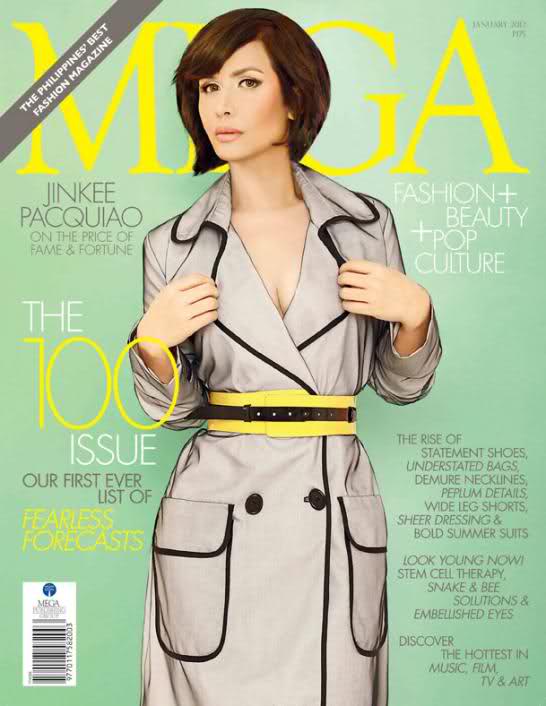Last week, two local magazines were criticized for what many thought were questionable editorial decisions.
On Friday, Cosmopolitan Philippines was called out by Hollywood actresses Lili Reinhart and Camila Mendes for altering photos to make them look skinnier. And over the weekend, the pre-wedding photo shoot of celebrity couple Billy Crawford and Coleen Garcia, which were posted on social media and published as an “exclusive” on the Metro Magazine website was criticized for being “racist” and allegedly using locals as “props.” (The article has since been taken down.)
Although these are the most recent examples of how magazines can miss the mark, especially when it comes to sensitive topics, they are far from being the only instances politically incorrect content have caused an uproar.
Philippine media has been accused of being racist, sexist, and insensitive many times and below are just five examples of when the public said: “enough is enough.”
Mega magazine’s 2012 cover with Jinkee Pacquiao

Fashion magazines are notorious for creating impossible standards of beauty and photoshopping pictures to make models look skinner has been done for years. One famous example of this is the Mega magazine cover featuring Manny Pacquiao’s wife, Jinkee Pacquiao.
Upon the release of the cover, many immediately noticed how different Jinkee looked in the photo and noted how it was obviously altered to make her neck longer and face smaller.
While the publication said that they did edit the photo, they maintained that it only underwent a “standard cleanup process that all MEGA magazine covers go through.”
Jinkee also denied that the photo was edited and challenged critics to come see how she looks in person.
“They’ll see that I really did lose weight,” she said.
READ: ‘Riverdale’ stars call out Cosmopolitan Philippines for photoshopping their bodies
FHM Philippines‘ 2012 cover with Bela Padilla

Philippine media has always played a role in the longstanding perception that “white is better,” and one example of this is an FHM Philippines cover that had actress Bela Padilla posing with dark-skinned models in the background. The cover story’s title? “Stepping Out of the Shadows.”
Naturally, many found the cover to be racist and thought it depicted white supremacy. FHM ended up pulling the magazine out from stands.
READ: The Color of Money: In Philippine TV and film, white still equals green
Philippine Tatler 2015 cover with Imee Marcos

“Beautiful. Strong. Enigmatic.” That’s how society magazine Philippine Tatler described Imee Marcos, the Ilocos Norte governor and daughter of dictator Ferdinand Marcos.
Many found the cover and feature story to be in bad taste, especially because Imee and her siblings still deny the corruption and human rights abuses that happened during their father’s reign.
While the family has yet to return the billions of dollars their patriarch stole from the country, they remain influential in Philippine society and politics. Imee is still the governor of Ilocos Norte, her brother Bonbong Marcos, was a senator and ran for vice president in 2016, and their mother Imelda Marcos is a congressperson, also for Ilocos Norte.
READ: Imee Marcos goes barefoot on Philippine Tatler cover
Pulp Magazine 2016 cover with Sud

Prior to the global #MeToo movement, it was not uncommon to find misogynistic photos in media. Case in point, music magazine Pulp thought it was ok to feature the band Sud on their cover as a production crew filming scantily clad women on a bed.
Many found the cover offensive and said that it was objectifying women.
While the band apologized for the photo, the magazine’s publisher, Vernon Go, still defended the concept. In a tweet, he said: “Photography of the female form that is sexy and provocative has nothing to do with misogyny. It is actual worship of the power of womankind.”
Photography of the female form that is sexy and provocative has nothing to do with misogyny. It is actual worship of the power of womankind.
— Vernon Go (@Vernon_Go) August 2, 2016
In November, members of Sud were met with sexual harassment allegations online, pushing the University of the Philippines to remove the band from its fair line-up.
Esquire Philippines‘ 2017 bashing of Jake Zyrus

In June last year, singer Charice Pempengco came out as transgender and said that he would like to be known as Jake Zyrus from then on. Reactions were mixed. Many were supportive but the cruel side of the internet also turned him into a meme. But that isn’t really surprising.
What was, though, was a piece published on the Esquire Philippines website that made fun of Zyrus’ new name.
Esquire, which prides itself in being open-minded and inclusive, thought it would be cool to poke fun at the name in an article titled “Jake Zyrus and The Challenges of Personal Reinvention.”
The article said: “[W]hile we stand in full support of Jake Zyrus’ decision, his new identity, and the right of every transgender person to identify with a name of his or her choosing, we can’t help but feel that Charice could have picked a better name than Jake Zyrus.”
Esquire eventually took the article down and issued an apology.
“Honestly, this did not even occur to us, because we are blockheads and are just not as enlightened as we thought we were. It’s simple as that,” it said. “While we have always championed equality for all people, regardless of sexual orientation, gender identity, religion, politics, race, or creed—not to mention the fact that our own team is remarkably diverse—it turns out that we have a long way to go in learning how to handle LGBTQ issues.”
The apology was also published with their takeaways from the GLAAD Media Reference Guide for Covering The Transgender Community and a Vice article about the importance of a trans person’s name.
READ: OPINION: Jake Zyrus deserves better
Did we miss anything? Can you recall other times the media was called out for controversial content? Let us know in the comments section below or tweet us @CoconutsManila.





Reader Interactions